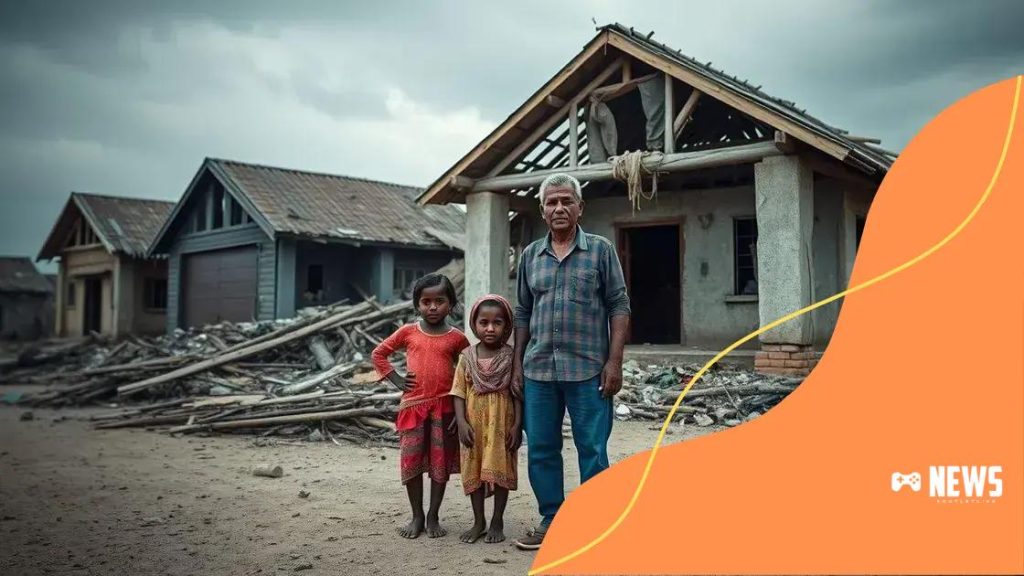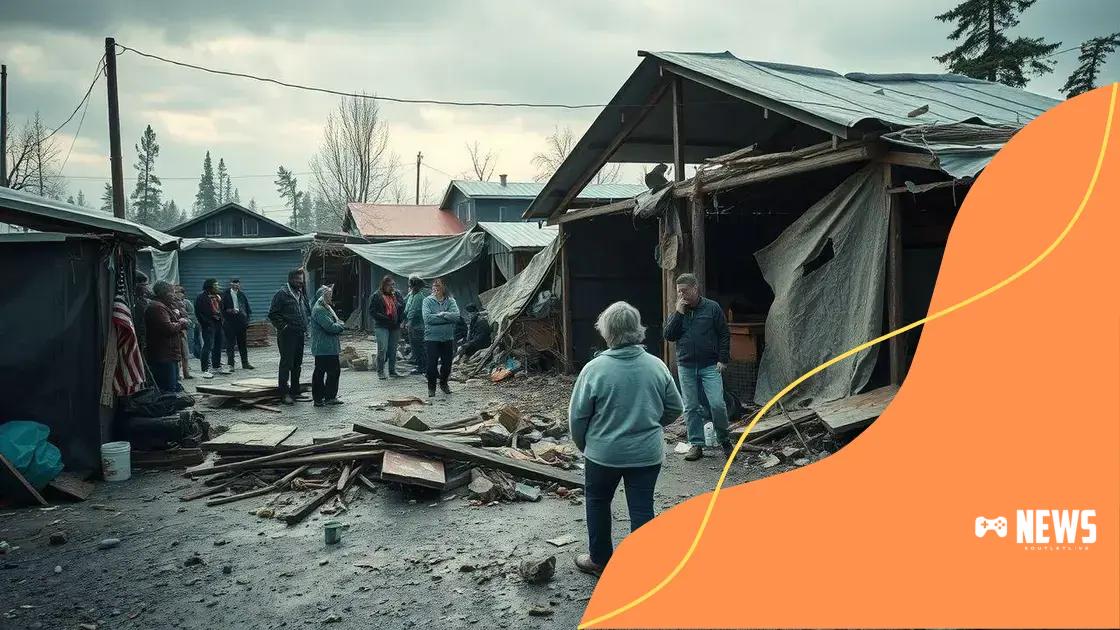Climate refugees: the urgent plight of displaced communities

Climate refugees are individuals forced to leave their homes due to severe environmental changes, facing significant challenges such as loss of livelihood, inadequate access to resources, and the need for humanitarian support.
Climate refugees are becoming a harsh reality in today’s world as environmental changes force people to leave their homes. Have you ever thought about how this impacts families and communities around the globe? Let’s delve deeper into their stories.
Understanding climate refugees
Understanding climate refugees is essential in today’s world. As the climate crisis intensifies, more people are forced to leave their homes. This phenomenon is often overlooked, yet its effects are profound and far-reaching. Let’s explore what it means to be a climate refugee and why it matters.
What are climate refugees?
Climate refugees are individuals or communities forced to flee their homes due to sudden or gradual changes in the environment. These changes can be caused by natural disasters, such as hurricanes, floods, or droughts. In other cases, gradual phenomena, like rising sea levels or desertification, lead to the need for relocation.
Key factors driving displacement
Several factors contribute to the rising number of climate refugees. Understanding these can help us address the challenges they face:
- Extreme weather events, like storms and floods, which can destroy homes.
- Long-term changes, such as drought or changing weather patterns, which reduce agricultural yield.
- Loss of biodiversity, affecting local resources and livelihoods.
- Increased competition for resources, leading to conflicts or further displacement.
As these factors intensify, the number of people affected continues to grow. It is estimated that millions could be displaced due to climate impacts in the coming decades. Each individual displaced represents a story of loss and resilience.
Moreover, the regions facing the most severe impacts often lack the resources needed to adapt to these changes. Therefore, understanding what drives this displacement is critical to devising effective solutions.
The human impact of climate change
The human cost of climate change goes beyond just economic factors. Social and psychological effects are also significant. Families and communities lose not only their homes but also cultural heritage and social networks. Without proper support systems, the adjustment period can be very challenging.
As we delve deeper into the context of climate refugees, we recognize that solutions must address not only the environmental drivers but also the human elements involved. We must ask ourselves how we can support these communities affected by climate change while creating sustainable solutions for the future.
The factors driving displacement
The factors driving displacement are complex and multifaceted. Various elements contribute to the increasing number of climate refugees. These factors can be divided into immediate and long-term causes that push communities away from their homes.
Immediate causes of displacement
Natural disasters often lead to sudden displacement. Events like hurricanes, floods, and wildfires can create immediate threats to life and property. When such disasters strike, entire communities may be forced to evacuate, losing their homes and livelihoods in the process.
- Severe storms that destroy infrastructure.
- Flooding that submerges homes and farmland.
- Wildfires that consume vast areas of land.
These events highlight how volatile environmental changes can disrupt lives in an instant, leaving individuals and families with difficult choices about their immediate future.
Long-term factors influencing displacement
In addition to sudden disasters, climate change brings about gradual changes in the environment. Over time, these slow shifts can make living conditions unbearable. For example, prolonged droughts can lead to crop failures, threatening food security.
Aside from environmental deterioration, social and economic factors also play a key role in displacement. Areas that face economic hardships may struggle to adapt to these changes. This situation can lead to increased migration as individuals seek better living conditions elsewhere.
Furthermore, with the loss of natural resources and livelihoods, communities often face conflicts over the remaining resources, further complicating their situation. These intricate dynamics reveal the interconnected nature of climate change and human vulnerability.
Understanding these factors is crucial for addressing the needs of climate refugees. By recognizing the causes of their displacement, we can better support these communities in their time of need and work towards preventing further crises.
Consequences for affected communities

The consequences for affected communities that experience displacement due to climate change are profound and often devastating. As these communities are uprooted, they face numerous challenges that impact their lives, well-being, and future.
Impact on social structures
When people are forced to leave their homes, the social fabric of their communities is often torn apart. Families may become separated during the evacuation, and social networks can disintegrate. These disruptions lead to feelings of isolation and loss.
- Loss of community support systems.
- Increased mental health issues like anxiety and depression.
- Compromised access to education for children.
As communities scatter, the spirit of togetherness can fade, leaving individuals to fend for themselves in unfamiliar environments.
Economic challenges
Displacement also brings significant economic consequences. Many affected individuals lose their jobs and sources of income, leading to financial instability. Without the ability to earn a living, families struggle to meet basic needs.
Additionally, the costs associated with moving—such as travel expenses and finding new housing—can place a heavy burden on already vulnerable populations. This economic strain can perpetuate cycles of poverty and limit access to essential services.
As businesses in these regions suffer or close entirely, communities face a long road to recovery. Rebuilding local economies and restoring jobs becomes crucial for long-term resilience.
Access to resources and services
Displaced families often face challenges in accessing vital resources like food, water, and healthcare. When communities relocate, they may not find adequate assistance in new areas. This can lead to higher rates of malnutrition and illness.
Without stable access to clean water and nutritious food, the health consequences can be severe. Many new communities may lack the infrastructure to support a sudden influx of displaced individuals, stressing resources and services already in place.
Ultimately, climate change’s repercussions extend beyond environmental damage. They create a ripple effect that impacts the very essence of communities, disrupting lives and futures in ways that require urgent attention and action.
Policy responses and humanitarian aid
Policy responses and humanitarian aid play crucial roles in addressing the challenges faced by climate refugees. As the number of displaced individuals continues to rise, governments and organizations must create effective strategies to support them.
National and international policies
Governments can implement policies that recognize the rights of climate refugees. This includes legal frameworks that provide protection and assistance to those displaced by environmental factors. Such policies may involve:
- Establishing clear definitions of climate refugees.
- Creating pathways for legal migration.
- Incorporating climate change considerations into disaster response plans.
International cooperation is also essential. Countries must work together to share resources, knowledge, and best practices to address the needs of displaced populations effectively.
Humanitarian aid and assistance programs
In addition to policy responses, humanitarian aid is vital in helping displaced communities recover. Aid organizations can provide immediate support in the form of food, shelter, and medical care. It is critical that this assistance addresses both short-term needs and long-term recovery.
Moreover, programs that focus on rebuilding communities and restoring livelihoods can empower climate refugees. This might involve:
- Providing job training and employment opportunities.
- Supporting small businesses and local economies.
- Implementing educational programs for displaced children.
Such initiatives help individuals regain their independence and rebuild their lives. Collaboration between governments, non-profits, and local communities is essential to ensure effective humanitarian responses.
By integrating policies and humanitarian aid, we can create a more resilient framework for addressing the challenges faced by climate refugees. This approach helps not only in immediate relief but also in fostering long-term sustainable solutions for affected communities.
Real-life stories of climate dislocation
Real-life stories of climate dislocation shed light on the personal experiences and struggles of those affected by environmental change. Each story is unique, portraying the emotional and physical toll of being uprooted from one’s home due to climate events.
Stories of families forced to flee
Many families have faced devastating losses as they are forced to leave everything behind. For instance, a family from a coastal town in Bangladesh lost their home to rising sea levels. They had to move to a crowded urban area, where they struggled to find work and rebuild their lives. Such challenges illustrate the profound impact of climate change on individual lives.
- Loss of homes and personal belongings.
- Challenges in securing employment and education.
- Feelings of anxiety and uncertainty about the future.
Each of these factors contributes to a complex emotional landscape for those displaced.
Experiences of indigenous communities
Indigenous communities are often among the first to face the effects of climate change. In the Arctic, for example, the Inuit people have seen their traditional hunting grounds disappear due to thawing ice. This not only threatens their way of life but also their cultural identity. Displacement is not just a physical relocation; it often means the loss of connection to ancestral lands.
These stories highlight how environmental changes can amplify existing inequalities. Indigenous voices are crucial in the conversation about climate actions and their rights must be prioritized.
Struggles and resilience
Despite the hardships, many individuals display incredible resilience. A group of farmers displaced by drought in East Africa has come together to form cooperative farms in their new locations. By sharing resources and knowledge, they are not only surviving but thriving, showing that solidarity can emerge from adversity.
Sharing these real-life stories helps to humanize the statistics often associated with climate refugees. Recognizing the faces behind these challenges can foster empathy and encourage action towards sustainable solutions.
FAQ – Climate Refugees and Their Impact
What are climate refugees?
Climate refugees are individuals who are forced to leave their homes due to sudden or gradual changes in the environment, such as natural disasters or climate impacts.
How does climate change create refugees?
Climate change leads to extreme weather events, rising sea levels, and resource scarcity, making it impossible for some communities to sustain their livelihoods.
What challenges do climate refugees face?
Climate refugees often face loss of homes, inadequate access to food and water, and difficulties in finding employment and educational opportunities in new areas.
What can be done to support climate refugees?
Supporting climate refugees requires effective policies, humanitarian aid, and community resilience programs to help them rebuild their lives and access necessary resources.





